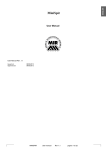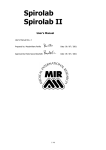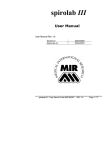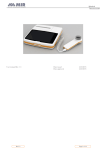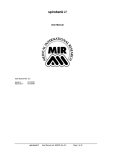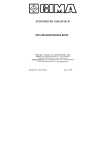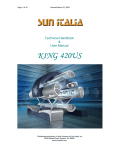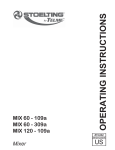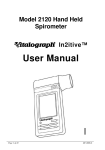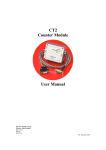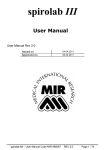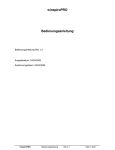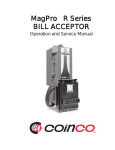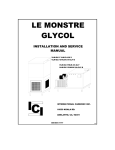Download MiniSpir - AJ Medical
Transcript
MiniSpir User Manual User Manual Rev. 1.6 Issued on: 29/11/2006 Approved on: 29/11/2006 MINISPIR User Manual Code 980255 Rev 1.6 page 1 of 24 Thank you for choosing a product from MIR MEDICAL INTERNATIONAL RESEARCH The original packaging contains: PRODUCT MiniSpir bag MiniSpir device MiniSpir User’s Manual 1 USB connection cable CD winspiroPRO 1 Nose Clip 3 paper mouthpiece 3 disposable turbine sensors (transparent) 1 reusable turbine sensor (coloured) CODE 672677 910580 980250 532365 920100 910320 910300 910001 910000 Before using your MiniSpir … • Read this manual carefully, plus all labels and other product information supplied. • Set the device configuration (date, time, predicted values, language etc.) as described in the Software WinspiroPro Manual. • Check PC system requirements for compatibility with the device (RAM: 128 Mb; Operating system: Windows 98 (Second Edition) – NT 4.0 – 2000 – ME - XP; Minimum disk space: 160 Mb; CPU 300Mhz or higher). • MiniSpir should only be connected to a computer manufactured in compliance with EN 60950/1992. ATTENTION The winspiroPRO PC software supplied with the device MUST be installed correctly to the PC before connecting MiniSpir to the PC. At the end of the installation, connect the device to the PC and the hardware will be "recognised" by the PC. The device can then be used with the winspiroPRO software. Keep the original packaging! In the event that your device requires attention then always use the original packaging to return it to the distributor or the manufacturer. In such an event then please follow these guidelines: • • Return the complete device in the original packaging, and The transport (plus any customs or taxes) costs must be prepaid. MINISPIR User Manual Code 980255 Rev 1.6 page 2 of 24 Manufacturer’s address MIR SRL: VIA DEL MAGGIOLINO, 125 00155 ROME (ITALY) Tel ++ 39 0622754777 Fax ++ 39 0622754785 Web site: www.spirometry.com Email: [email protected] MIR has a policy of continuous product development and improvement, and the manufacturer therefore reserves the right to modify and to update the information contained in this User’s Manual as required Any suggestions and or comments regarding this product should be sent via email to: [email protected]. Thank you. MIR accepts no responsibility for any loss or damage caused by the User of the device due to the use of this Manual and/or due to an incorrect use of the product. Note that due to printing limitations the screenshots shown in this manual may differ from the display of the machine and/or from the keyboard graphics. Copying this manual in whole or in part is strictly forbidden. FEDERAL LAW RESTRICTS THIS DEVICE TO SALE BY OR ON THE ORDER OF A PHYSICIAN MINISPIR User Manual Code 980255 Rev 1.6 page 3 of 24 INDEX 1. INTRODUCTION.....................................................................................................5 Intended Use...........................................................................................................5 User Category.........................................................................................................5 Ability and experience required...............................................................................5 Operating environment............................................................................................5 Who can or must make the installation ...................................................................6 Subject effect on the use of the device ...................................................................6 Limitations of use - Contraindications .....................................................................6 Important safety warnings .......................................................................................6 Danger of cross-contamination ...............................................................................7 Turbine....................................................................................................................7 Mouthpiece .............................................................................................................8 USB Connection Cable ...........................................................................................8 Device .....................................................................................................................8 Unforeseen errors ...................................................................................................9 Labels and symbols ................................................................................................9 Identification label .................................................................................................10 CE mark for medical devices ................................................................................10 Electrical safety symbol.........................................................................................10 Warning symbol for the USB serial port ................................................................10 Warning symbol for direct serial/parallel cable connection....................................10 Warning symbol for the WEEE..............................................................................10 Product description ...............................................................................................11 Spirometry test interpretation ................................................................................12 Technical features.................................................................................................12 Features of the spirometer ....................................................................................12 Other features .......................................................................................................14 2. FUNCTIONING OF THE MiniSpir .........................................................................14 2.1 Connection to PC ..................................................................................................14 2.2 Using the MiniSpir .................................................................................................15 2.3 Spirometry Testing ................................................................................................15 3. DATA TRANSMISSION ........................................................................................16 3.1 Transmission with USB cable ...............................................................................16 4. MAINTENANCE....................................................................................................16 4.1 Cleaning and controlling the reusable turbine .......................................................17 5. PROBLEM SOLVING............................................................................................18 5.1 Causes and Solutions ...........................................................................................18 LIMITED WARRANTY CONDITIONS.....................................................................................20 aNNEX 1 informaTION FOR corRECT USE IN ELECTROMAGNETIC ENVIRONMENTS.21 1.1 1.1.1 1.1.2 1.1.3 1.1.4 1.1.5 1.1.6 1.2 1.2.1 1.2.2 1.2.3 1.2.4 1.2.5 1.3 1.4 1.4.1 1.4.2 1.4.3 1.4.4 1.4.5 1.4.6 1.5 1.6 1.7 1.7.1 1.7.2 MINISPIR User Manual Code 980255 Rev 1.6 page 4 of 24 1. INTRODUCTION 1.1 Intended Use MiniSpir spirometer is intended to be used by either a physician, respiratory therapist or technician. The device is intended to test lung function and can make spirometry testing in people of all ages, excluding infants and neonates. It can be used in any setting. 1.1.1 User Category The MiniSpir spirometer calculates a series of parameters relating to human respiratory function. The product is therefore intended for use by a doctor or by a trained paramedic or technician under the supervision of a doctor. 1.1.2 Ability and experience required The correct use of the device, the interpretation of the results and the maintenance of the device, with particular attention to disinfection (cross-contamination risk), all require qualified personnel. ATTENTION The manufacturer cannot be held responsible for any damage caused by the user of the device failing to follow the instructions and warnings contained in this manual. If the user of the MiniSpir is a person considered to be cognitively impaired, then the operation of the device must be made under the supervision and responsibility of whoever is legally charged with the supervision of this person. 1.1.3 Operating environment MiniSpir has been designed for use in a doctor’s office or in a hospital setting. All information necessary for the proper use of the device in surrounding electromagnetic environments (as required by the EN 60601-1-2) is available from the manufacturer. The instrument is not intended for use in an operating theatre nor in the presence of inflammable liquids or detergents, nor in the presence of inflammable anaesthetic gases, oxygen or nitrogen. The instrument is not designed to be used in direct air currents (e.g. wind), sources of heat or cold, direct sun rays or other sources of light or energy, dust, sand or any other chemical substances. The user is responsible for ensuring that the device is stored and used in appropriate environmental conditions; in this regard reference is made to the specifics described in paragraph 1.7.2 below. ATTENTION If the device is exposed to unsuitable environmental conditions, this could cause the MINISPIR User Manual Code 980255 Rev 1.6 page 5 of 24 device to malfunction and to give incorrect results. 1.1.4 Who can or must make the installation The device requires installation by qualified personnel. 1.1.5 Subject effect on the use of the device A spirometry test should only be carried out when the subject is at rest and in good health, and thus in a suitable condition for the test. A spirometry test requires the collaboration of the subject since the subject must make a complete forced expiration, in order to have a meaningful test result. 1.1.6 Limitations of use - Contraindications An analysis of the results of a spirometry test is not by itself sufficient to make a correct diagnosis of the subject’s clinical condition. A detailed clinical history of the subject is also required together with the results of any other test(s) suggested by a doctor. Test comments, a test interpretation and suggested courses of treatment must be given by a doctor. A spirometry test requires the collaboration of the subject. The results depend on the person’s capability to inspire and to expire all air completely and as fast as possible. If these fundamental conditions are not respected then the results obtained during spirometry testing will not be considered accurate, and therefore the test results are “not acceptable”. The acceptability of a test is the responsibility of the user. Special attention should be given to testing elderly subjects, children and handicapped people. The device should never be used when it is possible or probable that the validity of the results may be compromised due to any such external factors. 1.2 Important safety warnings MiniSpir has been examined by an independent laboratory which has certified the conformity of the device to the European Safety Standards IEC 601-1 and guarantees the EMC Requirements within the limits laid down in the European Standard IEC 601-1-2. MiniSpir is continually controlled during its production and therefore the product confirms to the established security levels and quality standards laid down by the Council Directive 93/42/EEC for MEDICAL DEVICES. After removing the device from its packaging, check that there is no visible damage. In case of damage do not use the device and return it to the manufacturer for replacement. ATTENTION The safety and the correct performance of the device can only be assured if the user of the device respects all of the relevant safety rules and regulations. The manufacturer cannot be held responsible for damage caused by the failure of the user to follow these instructions correctly. The device must be used only and exclusively as a spirometer following the indications given by the manufacturer in the User Manual with particular attention to § MINISPIR User Manual Code 980255 Rev 1.6 page 6 of 24 Intended Use utilizing only original spare parts and accessories. Use of non original parts such as the turbine flow sensor and oximetry sensor or other accessories may cause errors in measurement and/or compromise the correct functioning of the device, and is therefore not permitted. In the event of any incident or accident of any kind resulting from the use of the device, the user is required to inform the manufacturer without delay, this procedure is laid down in Article.9 of the Legislative Decree No. 46/1997, which confirmed the EC Directive No. 93/42. 1.2.1 Danger of cross-contamination Two different types of turbine sensors can be used with the device: one is single-patient disposable and one is reusable. A mouthpiece is required in order to connect a subject to the spirometer. In order to avoid exposing the subject to the critical danger of crosscontamination, the reusable flow sensor must always be cleaned before each spirometry test, and always use a new disposable mouthpiece for each subject. The use of an anti bacterial filter is at the discretion of the doctor. If a disposable turbine is used, then a new one must be used for each patient. 1.2.2 Turbine Disposable turbine Reusable turbine If you are going to perform the spirometry test with a disposable turbine it is important to use a new turbine for every new patient. The characteristics, accuracy and the hygiene of the disposable turbine can only be guaranteed if it has been conserved beforehand in its original sealed packaging. The disposable turbine is made of plastic and its disposal after use should adhere to the local authority guidelines / norms. The correct funtioning of the re-usable turbine can only be guaranteed if it has been cleaned in the correct manner and is free from foreign bodies which could alter its movement. If the turbine has not been cleaned sufficiently this could cause cross contamination from one patient to another. Periodic cleaning should only be done when the instrument is for personal use and will only be used by one patient. The cleaning of the turbine should be done following the guidelines in the user manual. The following informations are valid for both models of turbine. Do not expose the turbine to a direct jet of water or air, and avoid contact with high temperature liquids. MINISPIR User Manual Code 980255 Rev 1.6 page 7 of 24 Do not allow dust or foreign bodies to enter the turbine sensor, in order to avoid incorrect functioning and possible damage. The presence of any impurities (such as hair, sputum, threads etc.) within the body of the turbine sensor may seriously compromise the accuracy of the measurements. 1.2.3 Mouthpiece Any disposable mouthpieces included with the device are supplied only as a guide to the correct type and dimensions of the mouthpiece required for this device, they are clean but not sterile. To purchase appropriate mouthpieces, generally either paper or plastic but in any case mono-use/disposable, we suggest that you contact your local distributor who supplied the spirometer. ATTENTION The use of a mouthpiece made from an inappropriate material could modify the biocompatibility and could be the cause of an incorrect functioning of the device and thus of incorrect test results, and create inconvenience to the patient. The user is responsible for obtaining the correct type of mouthpieces for the device. Those required are a standard type with an outside diameter of 30 mm, they are commonly used and in general easily procured. To avoid contamination of the environment, caused by the disposal of used mouthpieces, the user must follow all of the relevant local regulations in force. 1.2.4 USB Connection Cable Incorrect use or application of the USB cable may produce inaccurate measurements, which will show very inaccurate values of the patient’s condition. Carefully inspect each cable before use. Do not use cables that appear to be or are damaged. If a new cable is required, contact your local distributor. Use only cables supplied by MIR, specifically designed to be used with MiniSpir. The use of other types of cables can lead to inaccurate measurements. 1.2.5 Device ATTENTION The maintenance operations detailed in this manual must be carried out to the letter. If these instructions are not followed this can cause measurement errors and/or an incorrect test interpretation. Any modifications, adjustments, repairs or reconfiguration must be made by the manufacturer or by personnel authorised by the manufacturer. In case of problems, never attempt to make a repair oneself. The set-up of configurable parameters should MINISPIR User Manual Code 980255 Rev 1.6 page 8 of 24 only be made by qualified personnel. However, an incorrect set up of the parameters does not put the patient at risk. High-frequency emissions from “electronic” devices may interfere with the correct operation of the instrument. For this reason, certain minimum clearances (a few metres) should be observed when high-frequency appliances such as a TV, radio, portable phone, etc. and other electronic units are operated at the same time in the same room. The instrument may give inaccurate readings if operated in the presence of strong electromagnetic sources or in the presence of other medical devices such as echographies. If the PC and/or the printer connected to MiniSpir are used in the area containing the patient, its necessary that they conform to the EN 60601-1 Standard (ref. EN 60601-1-1 Standard). For the recycling of the MiniSpir, the accessories, plastic consumable materials (mouthpieces) plus the battery, use only the appropriate containers or return all such parts to the seller of the instrument or to a recycling centre. All applicable local regulations must be followed. If any of these rules are not followed then MIR will decline all responsibility for any direct or indirect damages, however caused. The instrument may be powered through a PC by a USB cable. Keep the device out of reach of children and of any person with mental handicap. 1.3 Unforeseen errors If any problems should arise with the device, a message indicating the nature of the problem will appear on the screen of the PC, together with a warning “beep”. Errors in measurement or in interpretation can also be caused by: • • • • • use by non-qualified or non-trained personnel, lacking ability or experience user error use of the instrument outside the guidelines described in this User' s Manual use of the instrument even when some operational anomalies are encountered non-authorised servicing of the instrument. 1.4 Labels and symbols MINISPIR User Manual Code 980255 Rev 1.6 page 9 of 24 1.4.1 Identification label The label shows: • Serial number of the device • Product name • Name and address of the manufacturer • Mark of conformity with the Directive 93/42 EEC • Electrical safety symbol 1.4.2 CE mark for medical devices 0476 This product is certified to conform to the Class II requirements of the 93/42/EEC medical devices directive. 1.4.3 Electrical safety symbol In accordance with IEC601-1 this product and its component parts are of type BF and therefore protected against the dangers of direct and indirect contact with electricity. 1.4.4 Warning symbol for the USB serial port 1.4.5 Warning symbol for direct serial/parallel cable connection 1.4.6 Warning symbol for the WEEE TURBINE This symbol is laid down in the European Standard 2002/96/EEC requirements of the European Parliament regarding the disposal of electrical and electronic devices (WEEE). At the end of its useful life this device must not be disposed of as normal domestic waste. Instead it must be delivered to a WEEE authorised collection centre. As an alternative, the device may be returned without charge to the dealer or distributor, when it is replaced by another equivalent device. MINISPIR User Manual Code 980255 Rev 1.6 page 10 of 24 Due to the construction materials used for the device, disposing it as a normal waste product could cause harm to the environment and/or health. Failure to observe these regulations can lead to prosecution. 1.5 Product description MiniSpir is a spirometer, and is connected to a Personal Computer using a USB cable. The device measures a range of respiratory parameters. A quality control check is carried out internally on the measured parameters. The main features of this multipurpose MiniSpir make it is easy to use and versatile. MiniSpir is a powerful and compact measurement device, intended for use by a respiratory specialist. It calculates up to 30 functional respiratory parameters, as well as the parameter comparison after the administration of a drug (PRE/POST) for a bronchodilator test or for a bronchial challenge test. A comparison of data is made between POST (after-drug) and PRE (before drug administration). The Pre test data relates to percentage variations between the measured results and the predicted values of the author based on the anthropometric data inserted. The flow and volume measurement sensor is a digital turbine, based on the infrared interruption principal, which ensures accuracy in time as required from a professional device. The special features of this kind of sensor are listed below: • • • • Accurate measurement even at very low flow rates (end of expiration) Not effected by gas humidity nor density Shockproof and unbreakable Inexpensive to replace. The two versions of the turbine flow measurement sensors, used on MiniSpir (single-patient disposable or reusable), ensure high precision in measurements and have the great advantage of requiring no periodic calibration. REUSEABLE TURBINE MINISPIR User Manual Code 980255 DISPOSABLE TURBINE Rev 1.6 page 11 of 24 However, the reusable turbine can be calibrated if required by the doctor. In order to maintain the characteristics of the turbines the following precautions must be closely observed: • for the single-patient disposable turbine: must always be substituted between patients. • for the reusable turbine: always clean the turbine between patients, to ensure the maximum level of hygiene and safety for the patient. For a correct interpretation of a spirometry test, the measured values must be compared either to the so-called normal or predicted values which are calculated from the anthropometric details of the patient or, alternatively, to the personal best values from the clinical history of the subject. The personal best values can vary considerably from the predicted values, which are taken from “healthy” subjects. Minispir connected to a PC through a USB port with Windows “WinSpiroPro” Software allows to view the information and to measure parameters for each test made by the patient. All spirometric test results plus the related subject details stored inside the device can be transferred from the device to the PC and then viewed (flow/volume curves, spirometry parameters). The device software gives an interpretation of each spirometry test and assigns a “traffic light” feedback (green, yellow and red) programmed by the doctor responsible for the system configuration (see software manual for further details). MiniSpir is able to make FVC, VC & IVC, MVV and breathing profile tests, calculates an index of test acceptability (quality control) plus reproducibility of the spirometry tests carried out. The automatic test interpretation follows the latest 11 level ATS (American Thoracic Society) classification. Each test can be repeated as required. The best parameters are always available for review. The normal (predicted) values can be selected from several normal “sets”. For example, within the European Union the majority of doctors use the ERS (European Respiratory Society) predicted values. For the configuration of parameters and storing tests, see the online manual of the WinSpiroPro Software. 1.6 Spirometry test interpretation The data stored in the MiniSpir and arranged by the software are available for interpretation by specialised personnel. The software gives an interpretation of each spirometry test by assigning a “traffic light” code and by comparing the previous values of the same subject or the reference values of the subject’s group. For further details see the online manual of the WinSpiroPro Software. 1.7 Technical features There follows a comprehensive description of the main features of the device. 1.7.1 Features of the spirometer MINISPIR User Manual Code 980255 Rev 1.6 page 12 of 24 Measured parameters: SYMBOL FVC FEV1 FEV1% FEV3 FEV3/FVC FEV6 FEV6% PEF FEF25 FEF50 FEF75 FEF2575 FET Vext FIVC FIV1 FIV1/FIVC PIF ELA *FVC *FEV1 *PEF VC IVC IC ERV FEV1/VC VT VE Rf ti te ti/t-tot VT/ti MVV(cal) *= best values DESCRIPTION Forced Vital Capacity st Volume expired in the 1 second of the test FEV1/FVC x100 Volume expired in the initial 3 seconds of the test FEV3/FVC x 100 Volume expired in the initial 6 seconds of the test FEV1/FEV6 x 100 Peak Expiratory Flow Forced Expiratory Flow at 25% of FVC Forced Expiratory Flow at 50% of FVC Forced Expiratory Flow at 75% of FVC Flow ratio at 25% and at 75% Forced expiratory time Extrapolated volume Forced inspiratory volume st Volume inspired in the 1 second of the test FIV1/FIVC x 100 Peak inspiratory flow Estimated lung age Best FVC Best FEV1 Best PEF Slow vital capacity (expiratory) Slow inspiratory vital capacity Inspiratory capacity Expiratory reserve volume FEV1/VC x 100 Tidal volume Ventilation per minute, at rest Respiratory frequency Average time of inspiration, at rest Average time of expiration, at rest Average time of inspiration / total time Average inspiratory flow, at rest Maximum voluntary ventilation calculated on FEV1 Flow/volume measurement system Temperature sensor Measurement principle Volume range Flow range MINISPIR User Manual Code 980255 m.u. L L % L % L % L/min L/s L/s L/s % S mL L L % L/s years L L L/s L L L L % L L/min S S min L/s L/min Bi-directional digital turbine semiconductor (0-45°C) Infrared interruption 10 L ± 16 L/s Rev 1.6 page 13 of 24 ± 3% or 50 mL ± 5% or 200 mL/s <0.5 cmH2O Volume accuracy Flow accuracy Dynamic resistance at 12 L/s 1.7.2 Other features Interface Power supply Dimensions Weight Type of electrical protection Grade of electrical protection Grade of protection against water ingress Level of safety in the presence of inflammable anaesthetic gas, oxygen or nitrogen Conditions of use Storage conditions Operating conditions Applied norms 2. USB USB connection 127x52x15 mm 66 grams (turbine included) Class II Device BF IPX1 device, protected against water drops Device not suitable Device for continuous use Temperature: MIN -20 °C, MAX + 60 °C Humidity: MIN 10% RH; MAX 95%RH Temperature: MIN + 10 °C, MAX + 40 °C; Humidity: MIN 10% RH; MAX 95%RH Electrical Safety Standard IEC 60601-1 Electro Magnetic Compatibility IEC 60601-12 FUNCTIONING OF THE MiniSpir 2.1 Connection to PC ATTENTION Before connecting MiniSpir by USB to a PC, the winspiroPro software must be installed to interface with the device. It is important, prior to initiating the following procedure, to know the version of the operating system installed on the PC used for the connection (from control panel click on the “System” icon, from the window, besides other information, the type of operating system installed on the PC can be checked). If winspiroPRO is already installed on the PC then a new installation is not required. MINISPIR User Manual Code 980255 Rev 1.6 page 14 of 24 To make the connection insert the mini USB already included into MiniSpir as shown in the picture: Next, attach the other connector to the USB port of the PC. When initially making a connection, the PC will, depending on the version of the operating system, either make an automatic driver installation or request some information. To avoid errors in this phase please read the winspiroPRO User Manual very carefully. To control the proper connection between the device and the PC check that the led on the device is lit. 2.2 Using the MiniSpir For correct use of the device and of accessory data required for the interpretation of the results (initial setup, turbine calibration, patient data management, viewing previous data and interpretation of results) see the winspiroPro software manual. 2.3 Spirometry Testing ATTENTION The device must only be used by qualified personnel with complete knowledge of spirometry; this is important for the correct execution of the tests, for the acceptability of measured parameters as well as for the correct interpretation of results. For correctly carrying out a spirometry test, it is strongly recommended to carefully follow the instructions as described below. • Insert the mouthpiece supplied into the protruding part of the turbine by at least 0.5 cm. • Fit the nose clip onto the nose of the subject to ensure that air cannot escape through the nostrils. • Hold MiniSpir in one hand as you would a cell phone. The side with the MiniSpir label should face the user. • Insert the mouthpiece well into the mouth beyond the teeth, being carefully to ensure that air cannot escape from the sides of the mouth. • It is suggested to make testing in a standing position and during an expiration lean forward, in order to help the expiratory action with a compression of the abdomen. ATTENTION Do not touch the USB cable during a test to avoid interfering with the transfer of data to the PC or stopping a test too soon. Please note it is indispensable for an accurate spirometry that all air must be expired MINISPIR User Manual Code 980255 Rev 1.6 page 15 of 24 from lungs. It is important to stress that the disposable mouthpiece and turbine must be changed at the end of each test. After 3 seconds from the initial forced expiratory MiniSpir emits a continuous beep, and also once again after 6 seconds. This is useful to the doctor to understand if the patient has reached the minimum expiry time pursuant to the requirements as set forth by the major international associations of pneumology. 3. DATA TRANSMISSION ATTENTION Read the instructions carefully before starting the transmission of data taking due care in ensuring that all the information has been properly understood. 3.1 Transmission with USB cable All data in the MiniSpir is transferred through a USB cable connection. Refer to Paragraph 2.1 of this Manual to connect the device to a PC. The data retrieved from MiniSpir during a spirometry test are sent to the PC in digital form and managed by the winspiroPro software. ATTENTION After a test session MiniSpir can be disconnected from the PC. To correctly disconnect the device (that is without the loss of data being transferred from MiniSpir to the PC) carefully follow the instructions below: When the device is connected to a PC this icon right on screen). appears on the tool bar (bottom 1) click on icon with left mouse button 2) the message box “Remove hardware” will appear 3) click on the message box with left mouse button 4) this message appears: “The device can now be safely removed from the system” 5) click on “OK” and disconnect the cable from the USB port If more than one USB device is connected at the same time, click with right mouse button on the icon and select MiniSpir from list; then select “disable” and wait for the message to remove the device. 4. MAINTENANCE MiniSpir is an instrument that requires very limited maintenance. The operations to perform periodically are: MINISPIR User Manual Code 980255 Rev 1.6 page 16 of 24 • • Cleaning and controlling of the reusable turbine. Changing the single-patient disposable turbine at each test. The maintenance operations set forth in the User’s Manual must be carried out carefully. Failing to observe the instructions contained in the manual may cause errors in measurement or in the interpretation of measured values. Modifications, adjustments, repairs, and reconfiguration must be carried out by the manufacturer or authorised persons. In case problems arise do not attempt to personally repair the unit. The setting of configuration parameters must be carried out by qualified personnel. In any case the risks pertaining to incorrect settings do not constitute a danger for the patient. 4.1 Cleaning and controlling the reusable turbine The flow and volume measurement turbine utilized on MiniSpir belongs to two categories: single-patient disposable and reusable. These guarantee a precision in measurements and have the great advantage of requiring no periodic calibration. In order to maintain these characteristics of the turbine a simple cleaning is required prior to each use (only for the reusable turbine). Cleaning of the disposable turbine is not required as it is supplied already clean in a sealed plastic bag. It must be disposed of after use. It is a good practice to control from time to time that dirt or foreign bodied are not deposited inside the turbine such as threads or worse, hair. Any such deposit could brake or block the rotation blade of the turbine and thus compromise the measurement accuracy. To clean the reusable turbine remove it from its compartment on the MiniSpir turning it anticlockwise and pressing lightly. It can be helpful to push it gently from underneath with one finger. Immerse the turbine in the recommended cold detergent solution, and move it within the liquid to remove any impurities which may be deposited inside. Leave the turbine immersed for the time specified in the instructions of the solution. To avoid causing irreparable damage never clean the turbine by placing it under a direct jet of water or any other liquid. Where no cleaning solutions are available it is however indispensable to clean the turbine in clean water. To avoid environmental contamination caused by the disposal of the cleaning solutions, the user must follow all local regulations. Rinse the turbine by immerging it in clean water (not hot). Shake off the excess water from the turbine and leave it to dry, standing it vertically on a dry surface. MINISPIR User Manual Code 980255 Rev 1.6 page 17 of 24 Once the turbine has been cleaned insert the turbine tube in its place according to the direction as indicated by the closed lock symbol printed on the plastic casing of the MiniSpir. To correctly insert the turbine push it to the end and turn it clockwise until reaching the wedge which ensures that the tube has been blocked inside the plastic casing. If the disposable turbine is used do not proceed to cleaning it but change it after each test. 5. PROBLEM SOLVING Here follow a list of problems that may arise when working with MiniSpir. Diagnostic messages are also automatically shown on the display indicating the type of malfunctioning: 5.1 • • Causes and Solutions MiniSpir does not connect with the PC Check that the two connectors of the USB cable and the PC are correctly inserted. If the position is correct the USB connection icon will appear in the tool bar; otherwise re-install the driver of the device. At end of spirometry testing the test data is not correct Clean the turbine and then control it; use a new turbine. MINISPIR User Manual Code 980255 Rev 1.6 page 18 of 24 srl MEDICAL INTERNATIONAL RESEARCH Via del Maggiolino 125, 00155 Rome - ITALY Declaration of EC Conformity Quality Management System according to the requirements of Annex II of the Medical Device Directive 93/42/EEC implemented by the Legislative Decree 46 dated 24/02/97 Notified Body CERMET No. 0476 - Certificate No. MED – 9826 La MIR srl Medical International Research, declares that the Device subject of this declaration together with its standard accessories conforms to the requirements of the Council Directive 93/42/EEC Annex I. Device Description Device Name Classification Spirometer MiniSpir IIa This Device is marked Any modifications to the Device which are not authorised by MIR will invalidate this Declaration Rome 01/03/2006 Simon Fowler Sales Manager Carmine Cerullo Quality Manager Rev.0 – Mod. PO-10DDC_MiniSpir MINISPIR User Manual Code 980255 Rev 1.6 page 19 of 24 LIMITED WARRANTY CONDITIONS MiniSpir, together with its standard accessories is guaranteed for a period of 12 months if intended for professional use (doctors, hospitals, etc.). The warranty is effective from the date of purchase contained in the relevant sales invoice or proof of purchase. The instrument must be checked at the time of purchase, or upon delivery, and any claims must be made immediately in writing to the manufacturer. This warranty covers the repair or the replacement (at the discretion of the manufacturer) of the product or of the defective parts without charge for the parts or for the labour. All batteries and other consumable parts are specifically excluded from the terms of this guarantee. This warranty is not valid, at the discretion of the manufacturer, in the following cases: • • • • • • • If the fault is due to an improper installation or operation of the machine, or if the installation does not conform to the current safety norms in the country of installation. If the product is utilised differently from the use described in the Users Manual. If any alteration, adjustment, modification or repair has been carried out by personnel not authorised by MIR. If the fault is caused by lack of or incorrect routine maintenance of the machine. If the machine has been dropped, damaged or subjected to physical or electrical stress. If the fault is caused by the mains or by another product to which the instrument has been connected. If the serial number of the instrument is missing, tampered with and/or not clearly legible. The repair or replacement described in this warranty is supplied for goods returned at the customers’ expense to our certified service centres. For details of these centres please contact your local supplier of the spirometer or contact the manufacturer directly. The customer is responsible for the transportation and for all transport and customs charges as well as for delivery charges of the goods both to and from the service centre. Any instrument or accessory returned must be accompanied by a clear and detailed explanation of the defect or problem found. If units are to be returned to the manufacturer then written or verbal permission must be received before any instruments are returned to MIR. MIR Medical International Research, reserves the right to modify the instrument if required, and a description of any modification made will be sent along with the returned goods. MINISPIR User Manual Code 980255 Rev 1.6 page 20 of 24 ANNEX 1 INFORMATION FOR ENVIRONMENTS CORRECT USE IN ELECTROMAGNETIC Guidance and manufacturer’s declaration – electromagnetic emissions The MiniSpir is intended for use in the electromagnetic environment specified below. The customer or the user of the MiniSpir should assure that it is used in such an environment. Emissions test Compliance Electromagnetic environment – guidance RF emissions Group 1 The MiniSpir uses RF energy only for CISPR 11 its internal function. Therefore, its RF emissions are very low and are not likely to cause any interference in nearby electronic equipment. RF emissions Class B CISPR 11 Harmonic emissions Not applicable IEC 61000-3-2 Voltage fluctuations/ Not applicable flicker emissions IEC 61000-3-3 MINISPIR User Manual Code 980255 Rev 1.6 page 21 of 24 Guidance and manufacturer’s declaration – electromagnetic immunity The MiniSpir is intended for use in the electromagnetic environment specified below. The customer or the user of the MiniSpir should assure that it is used in such an environment. Immunity test IEC 60601 Compliance level Electromagnetic environment test level –guidance Electrostatic discharge (ESD) IEC 61000-4-2 Electrical fast transient/burst IEC 61000-4-4 Surge IEC 61000-4-5 Voltage dips, short interruptions and voltage variations on power supply input lines IEC 61000-4-11 ±6 kV contact ±6 kV contact ±8 kV air ±8 kV air ±1 kV input/output lines for ±1 kV differential mode ±2 kV common mode <5 % UT (>95 % dip in UT) for 0,5 cycle Not Applicable Floors should be wood, concrete or ceramic tile. If floors are covered with synthetic material, the relative humidity should be at least 30 %. Mains power quality should be that of a typical commercial or hospital environment. Mains power quality should be that of a typical commercial or hospital environment. Not Applicable 40 % UT (60 % dip in UT) for 5 cycles 70 % UT (30 % dip in UT) for 25 cycles Power frequency (50/60 Hz) magnetic field <5 % UT (>95 % dip in UT) for 5 sec 3 A/m 3 A/m IEC 61000-4-8 Portable and mobile RF communications equipment should be used no closer to any part of the MiniSpir, including cables, than the recommended separation distance calculated from the equation applicable to the frequency of the transmitter. Recommended separation distance Conducted RF 3 Vrms IEC 61000-4-6 150 kHz to 80 MHz MINISPIR Power frequency magnetic fields should be at levels characteristic of a typical location in a typical commercial or hospital environment. [3 ] V User Manual Code 980255 d=[ 3.5 ] 3 P d=[ 3.5 ] 3 P 80 MHz to 800 GHz d=[ 7 3 Rev 1.6 ] P 800 MHz to 2,5 GHz page 22 of 24 Radiated RF 3 V/m IEC 61000-4-3 80 MHz to 2,5 GHz [3 ] V/m where P is the maximum output power rating of the transmitter in watts (W) according to the transmitter manufacturer and d is the recommended separation distance in metres (m). Field strengths from fixed RF transmitters, as determined by an electromagnetic site survey, should be less than the compliance level in each frequency range.b Interference may occur in the vicinity of equipment marked with the following symbol: NOTE UT is the a.c. mains voltage prior to application of the test level. NOTE 1 At 80 MHz and 800 MHz, the higher frequency range applies. NOTE 2 These guidelines may not apply in all situations. Electromagnetic propagation is affected by absorption and reflection from structures, objects and people. a Field strengths from fixed transmitters, such as base stations for radio (cellular/cordless) telephones and land mobile radios, amateur radio, AM and FM radio broadcast and TV broadcast cannot be predicted theoretically with accuracy. To assess the electromagnetic environment due to fixed RF transmitters, an electromagnetic site survey should be considered. If the measured field strength in the location in which the MiniSpir is used exceeds the applicable RF compliance level above, the MiniSpir should be observed to verify normal operation. If abnormal performance is observed, additional measures may be necessary, such as reorienting or relocating the MiniSpir. b Over the frequency range 150 kHz to 80 MHz, field strengths should be less than [3] V/m. MINISPIR User Manual Code 980255 Rev 1.6 page 23 of 24 Recommended separation distances between portable and mobile RF communications equipment and the MiniSpir The MiniSpir is intended for use in an electromagnetic environment in which radiated RF disturbances are controlled. The customer or the user of the MiniSpir can help prevent electromagnetic interference by maintaining a minimum distance between portable and mobile RF communications equipment (transmitters) and the MiniSpir as recommended below, according to the maximum output power of the communications equipment. Rated maximum output power of transmitter W 0.01 0.1 1 10 100 Separation distance according to frequency of transmitter m 150 kHz to 80 MHz 80 MHz to 800 MHz 800 MHz to 2,5 GHz d=[ 3.5 ] V1 P 0.12 0.37 1.17 5.28 11.66 d=[ 3.5 ] E1 P d=[ 7 ] E1 0.24 0.37 1.17 5.28 11.66 P 0.24 0.74 2.34 1.056 23.32 For transmitters rated at a maximum output power not listed above, the recommended separation distance d inmetres (m) can be estimated using the equation applicable to the frequency of the transmitter, where P is themaximum output power rating of the transmitter in watts (W) according to the transmitter manufacturer. NOTE 1 At 80 MHz and 800 MHz, the separation distance for the higher frequency range applies. NOTE 2 These guidelines may not apply in all situations. Electromagnetic propagation is affected by absorption and reflection from structures, objects and people. MINISPIR User Manual Code 980255 Rev 1.6 page 24 of 24
























